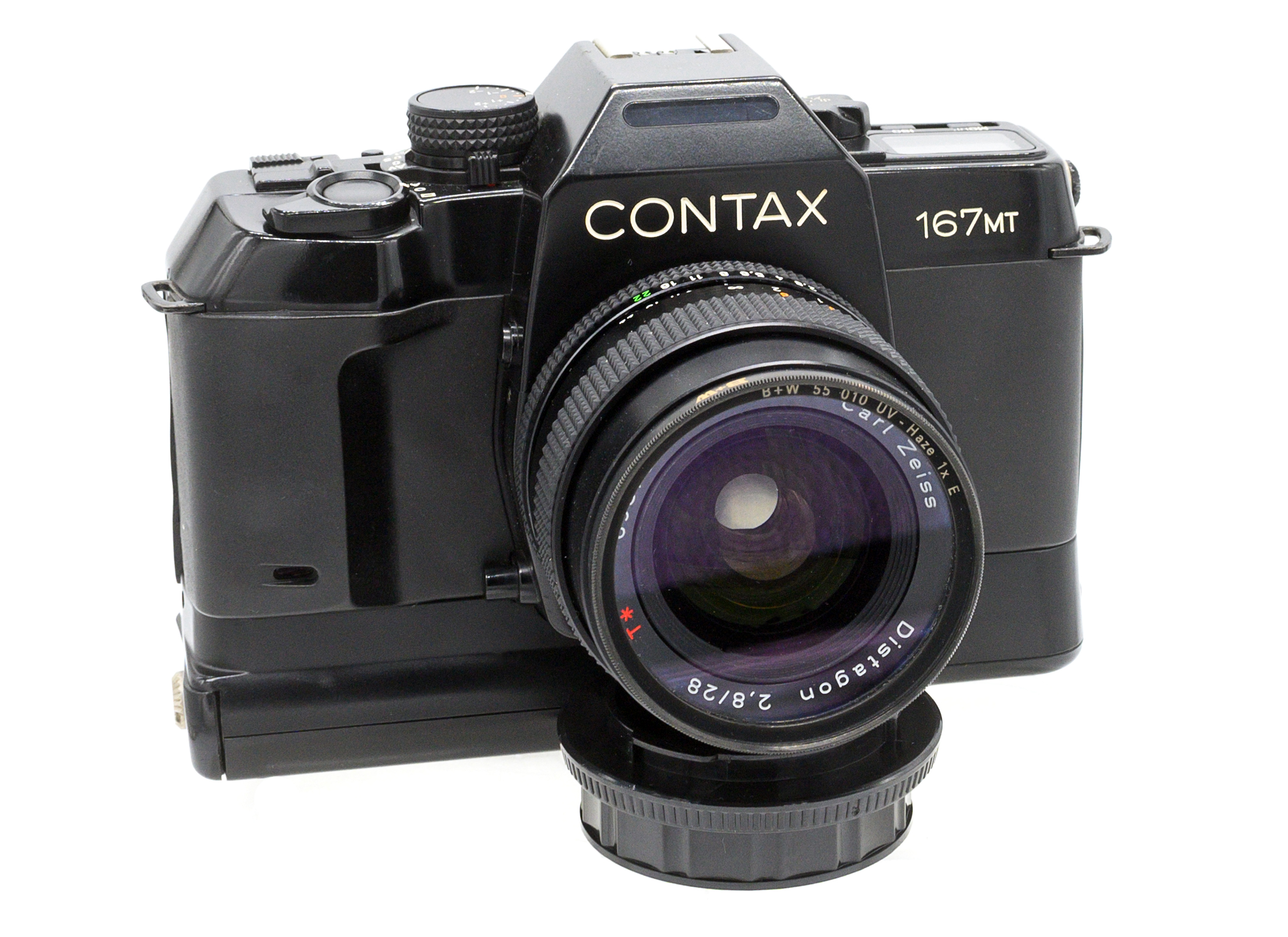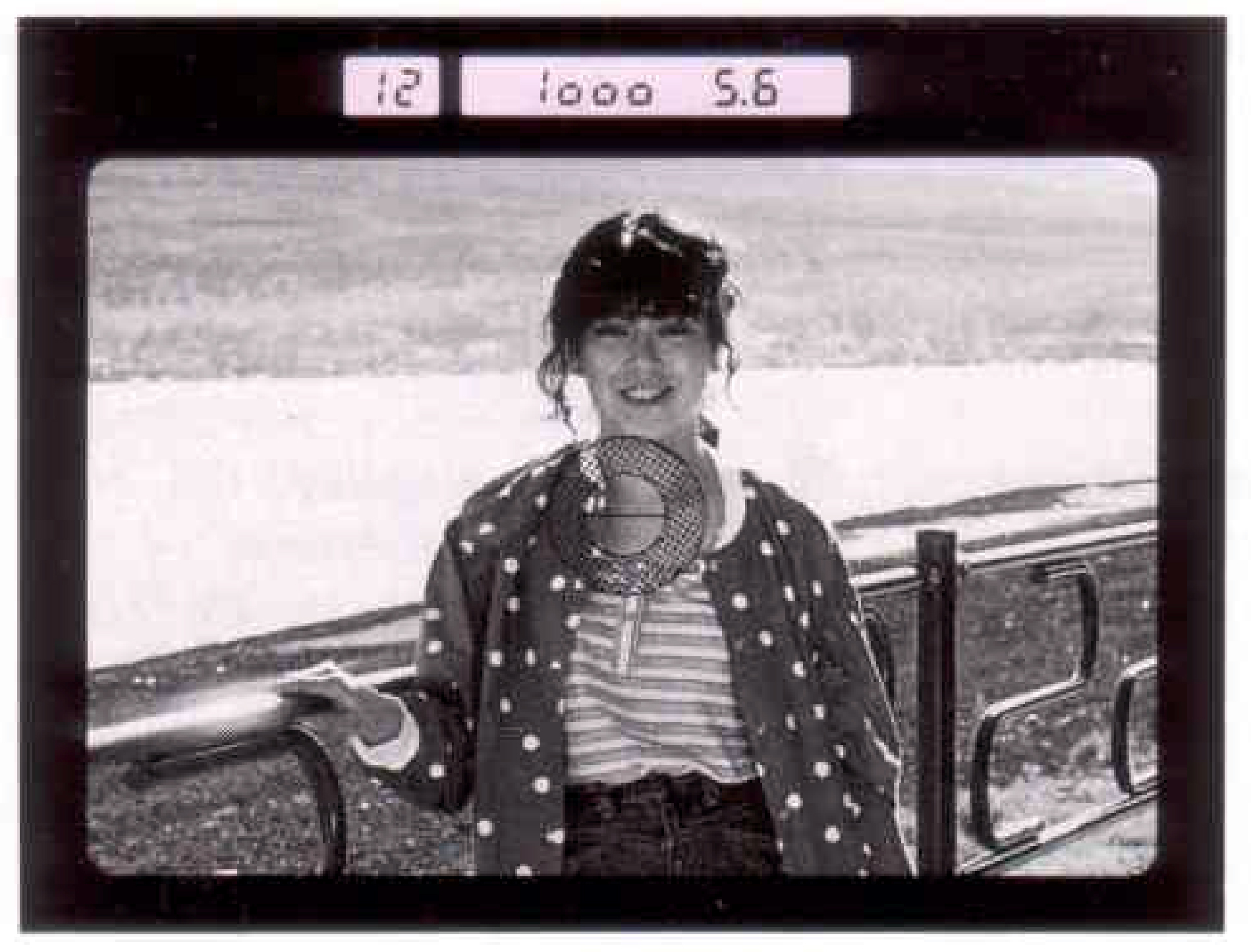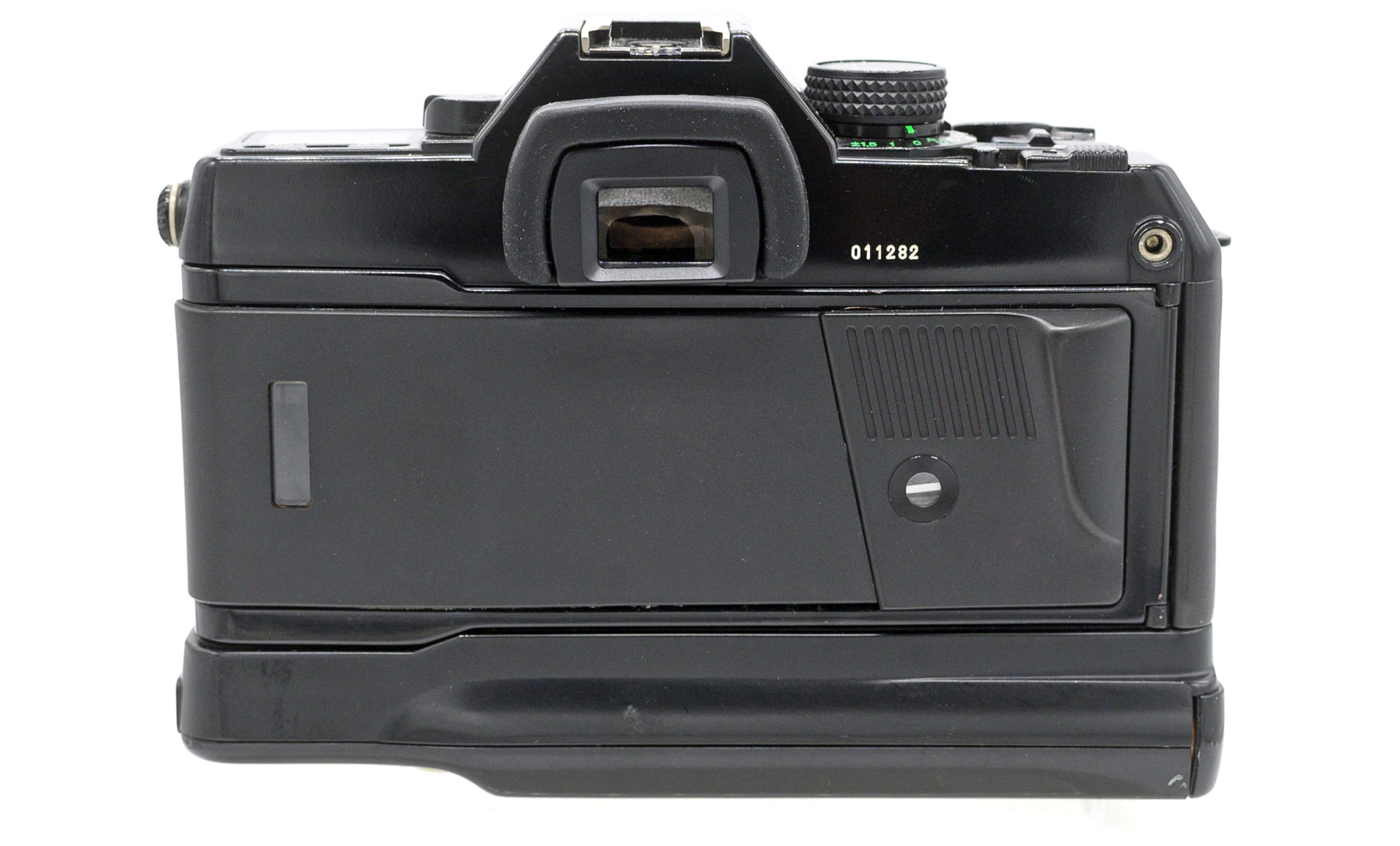
Shortly after the introduction of the full-featured Contax 159MM in 1985, Kyocera followed up almost immediately with the 167MT in 1986 as a successor to the 1982 Contax 137 MA. The 167MT was an abrupt departure from the prior 137/139/159 series and was intended to compete with the next generation of 35mm SLRs like the manual-focus Canon T90, the Ricoh XR-M, and the Nikon N2000 (F-301). It was also quite expensive, about $600 for the body at the time. With Kyocera not replacing the professional 1982 Contax RTS II until 1990, cameras like the 167MT with its advanced electronics and higher shutter speeds would have to fill the void, at least temporarily. In 1992, Kyocera replaced the the 167MT with the “ST,” a camera with nearly the same functionality but with “knobs and dials” instead of LCD readouts and buttons displays, and a 1/6000 top speed instead of 1/4000.
With used 167MTs appearing to be pretty cheap entries into the Contax SLR world, they have always been somewhat popular. Is it a good option? Let’s take a look.
Specifications
Here are the 159MM, 167MT, and ST compared.
| 159MM | 167MT | ST | |
| Year Introduced | 1985 | 1986 | 1992 |
| VF Coverage | 95% / 0.82x | 95% / 0.82x | 95% / 0.82x |
| Shutter Speeds | 60 sec – 1/4000 | 16 sec – 1/4000 | 16 sec – 1/6000 |
| Metering Modes | Center | Center / Spot | Center / Spot |
| Autoexposure Modes | P / A | P / A / S | P / A / S |
| Motor Drive | External | Advance / Load / Rewind | Advance / Load / Rewind |
| Advance Speed | 3 FPS | 3 FPS | 3 FPS |
| TTL Flash? | Yes | Yes | Yes |
| Flash Sync | 1/100 | 1/125 | 1/200 |
| Viewfinder Info | Shutter Speed / Aperture | Shutter Speed / Aperture / Frame Count | Shutter Speed / Aperture / Frame Count |
| Batteries | 2 x SR44 | 4 x AAA or AA (Optional) | 4 x AAA or AA (Optional) |
| AE Lock? | Yes | Yes | Yes |
| ASA Range | 12 – 3200 | 6-6400 | 6 – 6400 |
| Weight | 520g | 620g | 800g |

Operation
The 167MT is an orphaned design in the Contax SLR lineup. With an LCD screen replacing some of the traditional knobs and switches and with a viewfinder LCD reminiscent of that in the Nikon F4, the 167MT takes a little getting used to. While top-mounted LCDs on SLRs were all the rage during the mid-to-late 1980s, whether they actually assist with real-world shooting is a matter of preference. Although the LCD screen certainly adds some convenience and renders settings easier to visualize, it makes using shutter speed priority and manual modes somewhat time-consuming. Otherwise, the 167MT demonstrates the quality and attention to detail that one would expect from Contax’s mid-range line of SLRs.
Lenses: There are four categories of lenses in the C/Y mount: (1) Contax AE lenses (pre-1985); (2) Contax MM lenses (post-1985); (3) Yashica ML lenses; and (4) third-party lenses made by Tokina, Cosina, and others. The 167MT can use all of these lenses but can only use the “MM” lenses with its program and shutter-speed priority modes. All other lenses can only be used in aperture-priority or manual modes.
Viewfinder: Like most all Contax bodies, the 167MT has an excellent, bright, but not quite professional viewfinder. 95% viewfinder coverage with a 0.82x magnification is just above average for the era. With the 167MT, Contax first adopted an LCD to display the exposure information (in green, no less). The LCD displays the aperture, the shutter speed, the exposure mode, and the frame count. Half-pressing the shutter button will light up the readings with a green light (still a little difficult to see in the daytime). The viewfinder does have an illuminator light for tough conditions.

Exposure Modes: The 167MT has three program modes (high, normal, and low), aperture priority, shutter speed priority, and manual. These modes are selected via a switch on the top of the camera and displayed on the top LCD screen. Contax MM lenses are required for the program and shutter speed priority modes. Program mode has the camera set the appropriate shutter speed and aperture combination for a particular shot. Program high is to maximize the aperture opening and shutter speed, and program low is to minimize the aperture opening and shutter speed. The 167MT’s exposure chart shows that the programming is fairly aggressive in this regard, with a maximum difference of five exposure stops between High and Low, exactly what you would want.
Aperture priority operation is straightforward. Choose the aperture and the camera sets the appropriate shutter speed. Manual mode is easy as well. The viewfinder will tell you by a + or – sign whether the shutter speed is too high or too law for the selected aperture.
Metering and AE-L: The 167MT has the capability for center-weighted or spot metering, adjustable via a switch on the top right of the body. The autoexposure lock setting only works with spot metering. When using AE-L, half-depress the shutter button to create a “locked exposure” value at which you can shoot away after recomposing. While the AE-L is activated, and while in aperture-priority mode, you can change the aperture and the body will automatically adjust the shutter speed according to the prior-set exposure value. However, to get out of AE-L, you have to switch it off and on again. I have always found the Contax AE-L method somewhat cumbersome compared to systems like Nikon.
Winder: The 167MT was the first Contax SLR body with integrated film load, advance, and rewind. Film loading simply requires opening the back, pulling the film across, and closing the back. The rewind is not automatic at the end of a roll. Simultaneously pushing and button and sliding the rewind switch starts the process. The 167MT has two drive modes: Single and Continuous. The continuous advance is good for up to 3 frames per second, which is very respectable for a 1986 camera.
Batteries: The 167MT uses 4 x AAA bottom-loaded batteries to power the camera and the winder. An optional bulkier battery pack allows the use of 4 x AA batteries.
DX Coding: The 167MT was also the first Contax body to be able to read DX film coding. Film speed can also be manually set via the LCD screen.
Exposure Compensation: The 167MT has the ability to correct + / – 2 EV in 1/3 stop increments. A + or – sign appears in the viewfinder to indicate that the compensation switch has been activated. In program mode, compensation changes both the shutter speed and aperture, in aperture priority just the shutter speed, and in shutter priority just the aperture. The 167MT also has an auto-bracketing feature that is activated by a switch below the exposure compensation dial. Switch that on, put the advanced on “Continuous,” and the body will shoot three photos in a row at the appropriate spread.
TTL Flash: The 167MT has the capability for TTL flash exposure with all of the Contax TLA flash units. In program mode, the body will set the shutter speed and set the appropriate aperture. In aperture priority mode, you set the desired aperture, the camera sets the shutter speed and the TTL flash does the rest. For daylight fill in program mode, there are no additional steps. However, the relatively low max flash sync speed of 1/125 will result in a rather small aperture for most faster films. For daylight fill in aperture priority mode, set the aperture and the camera will set the shutter speed. However, if the aperture is too wide, the camera will blink an overexposure warning in the viewfinder. I am not quite sure how “advanced” the daylight fill system is as later professional cameras took complex readings of the background and foreground to calculate the appropriate settings.

Accessories
The 167MT had a few accessories.
F-3 Eyecup: This rubber eyecup that slides over the viewfinder will protect your glasses.
P-5 Battery Pack: The 167MT natively uses 4 x AAA batteries. To increase the weight and size of your 167MT, the P-5 battery pack is available and takes 4 x AA batteries for increased longevity.
The D-7 Databack: The databack replaces the backdoor of your camera. During the 1980s and 1990s, many camera manufacturers offered the ability to imprint the date/time on your actual negative, like in the lower left quarter of the frame. I am not sure where the D-7 imprints the data. The D-7 databack could also be used to program interval photography.
Focusing Screens: The 167MT can accept four different focusing screens: the FU-3 (45 degree split image), FU-4 (horizontal split screen), FU-5 (matte), and FU-6 (grid).


Possible Issues
An important issue to take into account before you plunge into a 167MT is the fact that Kyocera no longer services this camera and there are no spare parts. Although still rare, the electronics on these cameras can still catastrophically fail for reasons beyond your control. I had an 167MT where the shutter, while firing seemingly correctly, was not opening correctly and was subsequently declared unfixable. The other endemic issue that plagues both Kyocera-made Contax and Yashica SLRs is the dreaded “mirror slip,” where the glued-on mirror slips out of it housing, resulting in the inability to focus correctly. Reports of 167MTs failing has made me think twice about recommending it over other competitive Contax bodies.
Conclusions
Choosing a manual-focus Contax SLR can be a little daunting because the Kyocera produced so many cameras with overlapping features. The first fork in the road is whether you are looking for a body without an integrated drive. If not, the choices are easy: the electronic-shutter 159MM or the mechanical-shutter S2b. If looking at cameras other than the professional RTS III, the RX and Aria were overall the best. Choosing between the 167MT and the ST really comes down to whether you prefer the LCD or switches/knob experience. The only other differences are that the 167MT has two additional program modes, the ST has a 1/2 stop higher maximum shutter speed, and the ST has a slightly higher flash sync speed at 1/200. In my opinion, I do not think that the 167MT competes well with the post-1986 Contax bodies and paying a little more for an ST, RX, RTS III, or Aria is well worth it.
Got the 167 cheap in a pretty worn state, replaced some the rubber cover which got out of shape with leather. Like you mentioned control layout is a bit quirky. Also when using an old Tamron Adaptall lens the metering gave false values resulting in severe underexposure. Taking the same lens/adapter combo onto the Contax ST results are correct.
Side to side with a Contax ST I would pick the ST because of control layout, not willing to spend the cash for an Aria, the ST is my preferred “compact” Contax SLR.
I was wondering regarding the D-7 data back, does it print in between frames or inside the negative area? It was a bit unclear in the statement above regarding the data back.
I can’t say for certain but I would suspect that it prints the date outside the photo area in the space between. The ST does the same. However, it doesn’t go anywhere near the year 2022 so you’ll only be able to imprint the correct day and month.
Could you describe further the issue with the shutter that seemed to fire fine but something was wron with it? I have a 167mt and it seems that the shutter and the auto film rewind is off sync and I get light streaks from any light sources in the picture frame.
Hello! I had a similar issue with streaks and some photos not being exposed at all. A reputable repairperson took a look at it and said the electronic shutter had failed and that no spare parts existed to fix. It seems like this is not a rare occurrence for this model. This is why I advise staying away from 167MTs these days if other options are available.
Thanks! I bought recently the camera from a flea-market and shot one test roll with it. The exposure is spot on and the streaks only occur if I am shooting directly at a source of light. I used rechargeable AAA batteries, will give a try again with alkaline just to make sure.
you have bad light seals